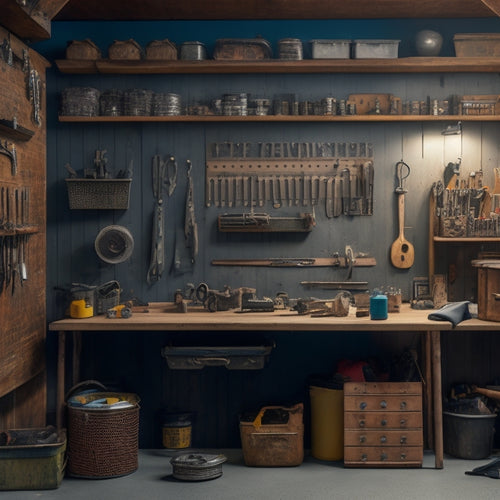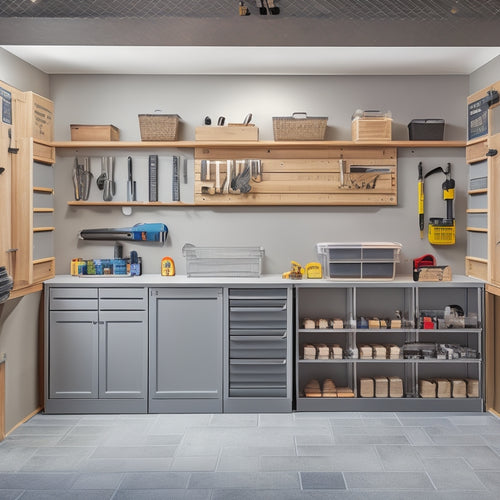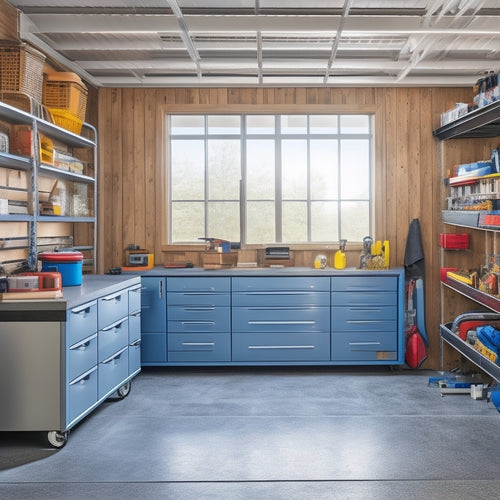
Tool Bins for Organizing Your Workspace
Share
You're likely no stranger to the frustration of wasted time and energy searching for misplaced tools and supplies in a cluttered workspace. Tool bins can be a transformative solution for organizing your workspace, offering benefits like streamlined organization, reduced accident risks, and prevention of tool damage. With various materials, sizes, and features to choose from, you'll want to assess your specific needs and research brands for reliability and customer satisfaction. By selecting the right tool bin and implementing effective organization ideas, you'll be well on your way to creating a more efficient and productive workspace - and there's even more to investigate to take your organization to the next level.
Key Takeaways
- Tool bins streamline workspace organization, reducing clutter and accident risks, while protecting tools and minimizing replacement costs.
- Choosing the right tool bin depends on intended use, material, size, and features such as compartments, portability, and stackability.
- Effective tool bin organization involves sorting tools into logical groups, categorizing, and allocating sections within bins for easy access.
- Regular maintenance is crucial, including inspecting bins, cleaning tools, and reassessing organization to adapt to changing needs.
- Popular tool bin brands include DeWalt, Milwaukee, and Stanley, offering durability and reliability, as well as budget-friendly options from Craftsman and Kobalt.
Benefits of Tool Bins
Streamline your workspace by incorporating tool bins into your organizational system, and you'll immediately notice the benefits.
By keeping your tools and supplies organized, you'll reduce the risk of accidents and injuries caused by tripping over clutter or searching for misplaced items. Tool bins also help prevent damage to your tools and equipment, which can be costly to replace.
Tool bins come in a variety of materials, such as plastic, metal, or wood, each with its own durability and maintenance requirements.
You can choose from different tool bin sizes to fit your specific needs, from small bins for storing small parts and accessories to large bins for holding bigger tools and equipment.
Choosing the Right Tool Bin
Considering your specific needs and workspace constraints, you're faced with an important decision: selecting the right tool bin for your organizational system. This choice is vital as it directly impacts tool accessibility and overall workspace efficiency.
When choosing a tool bin, consider the following factors:
| Bin Materials | Tool Accessibility | Workspace Constraints |
|---|---|---|
| Metal | Easy access with hooks and magnetic strips | Suitable for heavy tools and large workspaces |
| Plastic | Good for small tools and parts, with dividers for organization | Ideal for small to medium-sized workspaces |
| Wood | Aesthetically pleasing, with customizable dividers | Suitable for small workspaces, ideal for hand tools |
| Modular | Flexible and adjustable, with removable compartments | Ideal for workspaces with varying tool sizes and types |
| Portable | Lightweight and easy to move, with handles or wheels | Suitable for workspaces that require frequent tool transportation |
Tool Bin Organization Ideas
You'll get the most out of your tool bins by implementing a few key organization strategies.
Start by sorting and categorizing your tools into groups that make sense for your workflow, then label and sign each bin so you can quickly identify what's inside.
Sort and Categorize Tools
Create a home for each tool by sorting and categorizing them into logical groups. This step is essential in ensuring that your tool bins are organized and functional.
Start by grouping similar tool types together, such as hand tools, power tools, and measuring tools. Within each group, categorize tools by their function or the task they perform. For instance, you can have a category for drilling tools, cutting tools, and fastening tools under the power tools group.
When categorizing, consider the frequency of use and the storage solutions that will work best for each group. Tools that are used daily should be easily accessible, while less frequently used tools can be stored in harder-to-reach areas.
This will help you optimize your workspace and reduce clutter. By sorting and categorizing your tools, you'll be able to quickly find what you need, reducing downtime and increasing productivity.
Label and Sign Bins
Now that you've sorted and categorized your tools, it's time to make them easily identifiable by labeling and signing each bin. This step is essential in ensuring that you and others can quickly locate the tools they need, reducing the risk of accidents and increasing productivity.
When it comes to labeling techniques, consider using a combination of text and images to convey the contents of each bin. You can use a permanent marker to write the name of the tool or category on the bin, and add an icon or illustration to make it more visually appealing.
For bins that contain smaller items, consider using a label maker to create clear and concise labels.
For sign materials, choose durable and weather-resistant options that can withstand the conditions of your workspace. Plastic or metal signs with a clear coat can provide long-lasting protection against dust, moisture, and other environmental factors.
Make sure the text is large enough to read from a distance, and consider adding a color-coding system to further organize your bins. By labeling and signing your bins, you'll be able to maintain a safe and efficient workspace.
Maximize Vertical Space
Since every inch counts in a workspace, maximizing vertical space is essential for efficient tool bin organization. You can achieve this by utilizing shelf storage, vertical racks, and wall mounted bins to store infrequently used items, keeping them out of the way but still accessible.
Consider pegboard solutions with hooks and bins to hang tools and supplies, freeing up floor space. Overhead storage options, such as stackable containers or hanging organizers, can also be used to store less frequently used items.
Modular systems can be adjusted to fit your specific needs, allowing you to create a customized storage solution. By making the most of your vertical space, you'll be able to keep your workspace organized, reduce clutter, and improve safety.
With everything in its designated place, you'll be able to quickly find what you need, reducing the risk of accidents and increasing productivity.
Customizing Your Tool Bin
You'll get the most out of your tool bin by tailoring it to your specific needs.
Start by categorizing your tools into groups, such as hand tools, power tools, and fasteners, and then allocate separate sections of the bin to each category.
This approach will help you create a logical and efficient bin organization that saves you time and reduces frustration.
Bin Organization Ideas
Five minutes of intentional bin organization can revolutionize your workspace. By taking a few moments to customize your tool bin, you can increase efficiency, reduce clutter, and improve safety.
Start by considering the tool bin materials and sizes that best fit your needs. Do you need a bin with separate compartments to keep small parts organized? Or perhaps a larger bin to store bulkier tools?
Once you've selected the right bin, it's time to get organized.
Here are some bin organization ideas to get you started:
- Label each compartment or shelf to guarantee you can quickly find what you need
- Store frequently used tools in easy-to-reach locations
- Designate a specific area for sharp objects or hazardous materials
- Keep related tools together, such as all socket sets in one bin
- Implement a "first in, first out" system to guarantee older items are used before they expire or become obsolete
Tool Category Sorting
Sort your tools into categories to maximize your bin's storage potential. This step is essential in customizing your tool bin to fit your specific needs.
Start by grouping similar tool types together, such as hand tools, power tools, and accessories. Within each category, further divide tools into subgroups based on their function, size, or frequency of use. For example, hand tools can be divided into pliers, screwdrivers, and wrenches, while power tools can be separated into drills, saws, and sanders.
This categorization system allows you to identify the storage solutions that work best for each group. You can then assign specific compartments or dividers within your bin to each category, ensuring that every tool has a designated home.
This organization method prevents tools from getting jumbled together, reducing the risk of damage, loss, or injury. By categorizing your tools, you'll be able to quickly locate what you need, saving time and increasing productivity in your workspace.
Tool Bin Maintenance Tips
With a well-organized tool bin, it's essential to maintain it regularly to confirm it continues serving its purpose efficiently.
Regular maintenance not only guarantees your tools remain accessible but also prolongs the tool bin's durability. The materials used to construct your tool bin can affect its maintenance needs, so be sure to take into account the specific requirements of your bin.
To keep your tool bin in top condition, follow these maintenance tips:
- Clean your tool bin regularly to prevent dirt and debris buildup, which can damage the materials or tools.
- Check for any signs of wear and tear, such as rust or corrosion, and address them promptly.
- Verify all tools are properly stored and secured to prevent them from shifting during transport or storage.
- Lubricate any moving parts, like hinges or latches, to keep them functioning smoothly.
- Periodically inspect your tool bin for any signs of pest or rodent infestation, and take action if necessary.
Popular Tool Bin Brands
As you search for the ideal tool bin to meet your specific needs, considering popular brands can be a great starting point. When it comes to brand comparisons, you'll find that some names stand out for their quality and reliability. DeWalt, Milwaukee, and Stanley are well-known for their durable tool bins that can withstand heavy use.
If you're on a budget, consider brands like Craftsman or Kobalt, which offer affordable options without sacrificing functionality.
When evaluating tool bin brands, think about your specific needs. Do you need a bin with compartments for organizing small parts, or one with a large capacity for storing bulky tools? Look for brands that offer customization options or modular designs to fit your unique requirements.
Additionally, consider the material and construction of the tool bin. A sturdy, rust-resistant bin will guarantee your tools remain protected and organized for years to come.
Frequently Asked Questions
Can Tool Bins Be Mounted on a Pegboard or Wall?
You can easily mount tool bins on a pegboard or wall using various mounting methods, ensuring a secure and organized workspace. Look for bins with pegboard-compatible hooks or screws for a hassle-free installation that prioritizes safety.
Are Tool Bins Suitable for Outdoor or Garage Use?
As you venture into the great outdoors or your garage, you'll need storage that can withstand the elements. Look for tool bins with weather-resistant materials and size options to fit your specific needs, ensuring your tools stay protected and within reach.
Do Tool Bins Come With Dividers or Compartments?
You'll find that many tool bins come with dividers or compartments, offering flexibility in organizing your tools and equipment. Look for bins with adjustable compartments or removable dividers to customize your storage needs and guarantee easy access to your tools.
Can Tool Bins Be Locked or Secured With a Latch?
Let's get real, you don't want your tools walking off, do you? Luckily, many tool bins come equipped with locking mechanisms and security features, like latches or padlock holes, to keep your gear safe and secure.
Are Tool Bins Made From Recyclable or Eco-Friendly Materials?
When shopping for storage solutions, you'll find many brands offering tool bins made from sustainable materials, reducing environmental impact. Look for products with recyclable materials, bioplastics, or FSC-certified wood to minimize your ecological footprint.
Conclusion
As you stand in your newly organized workspace, surrounded by tidy tool bins, you can't help but feel a sense of satisfaction and accomplishment. It's like a weight has been lifted off your shoulders, and you're ready to tackle any project that comes your way. Remember, a well-organized workspace is not just about aesthetics; it's about efficiency, productivity, and peace of mind. So, take a deep breath, revel in your newfound sense of control, and get to work – your tools are waiting!
Related Posts
-

Design Considerations for a Custom Pegboard
When designing a custom pegboard, you'll want to start by evaluating your storage needs, considering factors like too...
-

Essential Steps for Garage Storage System Design
You're about to change your cluttered garage into an organized haven by following a structured approach to garage sto...
-

Top Rolling Tool Box Drawers for Maximum Storage
When it comes to maximizing storage with rolling tool box drawers, you need a solution that combines durability, cust...


